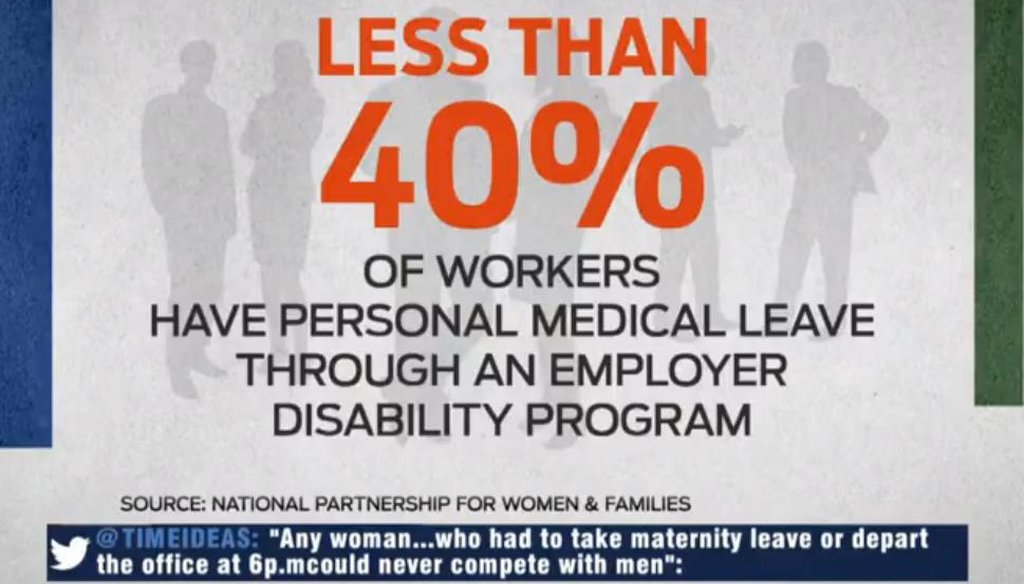

Our only agenda is to publish the truth so you can be an informed participant in democracy.
We need your help.


Vicki Shabo of the National Partnership for Women and Families used this statistic to explain why she supports the FAMILY Act on MSNBC's "The Cycle" on Dec. 12, 2013. Screenshot | MSNBC
Panelists on MSNBC’s The Cycle chewed on the topic of mandatory paid leave -- and how it isn’t a thing for all American workers -- on the heels of new legislation from Democrats that would create a program to make it happen.
The Family and Medical Insurance Leave (FAMILY) Act, sponsored by Sen. Kirsten Gillibrand, D-N.Y., and Rep. Rosa DeLauro, D-Conn., would allow workers to take up to 12 weeks of paid family and sick leave through the creation of a trust fund, administered by the Social Security Administration, that would be funded by contributions from employers and employees of 0.2 percent of earnings (2 cents per $10).
One big supporter is the National Partnership for Women and Families, which was very involved in the passage of the Family and Medical Insurance Leave Act of 1993 that guaranteed 12 weeks of unpaid leave for most workers. Now, the group is pushing for the law to go even further so that more workers can take off -- and be paid -- during emergencies.
America is far behind the modern world in the area of paid leave, said Cycle guest Vicki Shabo, director of work and family programs at the National Partnership for Women and Families, on Dec. 12, 2013.
"About 40 percent of workers don’t even have a single paid sick day," Shabo said, "much less the long-term leave that the FAMILY Act would provide."
We wondered if her statistic was accurate.
Her source: the U.S. Bureau of Labor Statistics’ 2013 National Compensation Survey.
The data show 61 percent of all private-sector workers were offered paid sick leave, leaving about 40 percent without it. The BLS count for public and private workers, excluding those who are self-employed or work for the federal government, is a tad higher at 65 percent. State and local government workers have a much higher rate of getting paid sick leave compared to other sectors, at about 89 percent.
Employees of smaller firms and the leisure and hospitality sector are the least likely to have paid medical leave, the survey shows. The rate of paid sick leave increases with pay level, with the rise of white-collar jobs being the main reason that more workers have access to paid sick leave than 20 years ago.
Under current law, workers are eligible for 12 weeks of unpaid, job-protected leave per year for reasons that include childbirth, caring for a spouse, child or parent with a serious health issue, dealing with a serious health problem of their own, among others.
According to the Department of Labor, nearly 60 percent of workers are eligible for unpaid leave through the Family and Medical Insurance Leave Act of 1993, and 13 percent reported taking leave under FMLA in the past year.
The Gillibrand-DeLauro proposal would provide leave to every worker, including those who work for smaller employers or are self-employed or unemployed, "as long as the person has sufficient earnings and work history," according to a DeLauro press release. The idea is modeled after programs in California and New Jersey. Payments to employees on leave would be equal up to 66 percent of monthly income, capped at a monthly amount.
We checked in with the conservative Employment Policies Institute, which opposes pro-labor policies. Research director Michael Saltsman said Shabo's statistic, while accurately sourced, does not account for workers given a pool of hours to use for vacation, illness or personal reasons.
Widening the scope shows 77 percent of private-sector workers receive paid vacation time, he said, referencing the BLS.
"Of course, that makes the statistic appear far less 'shocking' than Shabo would like it to be," Saltsman said.
Consolidated leave plans, which offer employees a block of leave time per year to use for various reasons, are becoming more popular for American workers, particularly those in the insurance and health care sectors, according to the BLS. The BLS found 26 percent of all workers were offered consolidated leave plans in 2012.
Our ruling
Shabo accurately referenced 2013 federal data when she said, "About 40 percent of workers don’t even have a single paid sick day." Saltsman did offer one caveat, however, noting that some workers have a pool of days that can be used for illness or vacation.
That caveat is enough to rate this claim Mostly True.
MSNBC The Cycle, "An important act for American families," Dec. 12, 2013
U.S. Bureau of Labor Statistics, National Compensation Survey, published March 2013
Interview with Sadie Kliner, National Partnership for Women and Families spokeswoman, Dec. 13, 2013
PolitiFact Ohio, "Sen. Sherrod Brown says three-quarters of low-income workers don’t have paid sick days," Feb. 11, 2013
PolitiFact Obameter, "Require employers to provide seven paid sick days," Sept. 30, 2011
National Partnership for Women and Families press release, "The FAMILY Act is Badly Needed to Update the Outdated Workplace Policies That Are Hurting America’s Families," Dec. 12, 2013
Center for American Progress, "What is the FAMILY Act? Facts and frequently asked questions," Dec. 12, 2013
New York Times Motherlode parenting blog, "New act proposes national family leave policy," Dec. 11, 2013
National Partnership for Women and Families, "A bittersweet labor day," Aug. 30, 2013
Bureau of Labor Statistics Beyond the Numbers, "Paid leave in private industry over the past 20 years," August 2013
Interview with Michael Saltsman, research director of the Employment Policies Institute, Dec. 13, 2013
In a world of wild talk and fake news, help us stand up for the facts.
